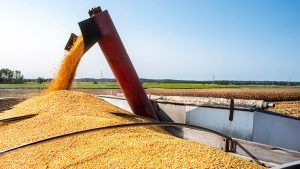Ontario wheat holds strong
2020 EXTREMES

WHEAT IS HARVESTED somewhere in the world every month except February. The constant global supply makes it challenging to keep tabs on the dynamics of wheat marketing.
Todd Austin, marketing manager for Grain Farmers of Ontario, knows the ins and outs of Ontario’s wheat market and all the factors that influence pricing — supply and demand, global influences, and market factors. It’s no surprise Austin reported more extremes in the marketplace in 2020, after all, no one could have predicted COVID-19, and how the global pandemic would impact commodity markets and prices available to Ontario farmers.
A LOOK BACK AT 2020
“Ontario wheat farmers harvested approximately one million acres in 2020, reporting decent quality across the province. Pricing was steady, with a surprise market rally in late summer,” says Austin. “Overall, wheat performed well in 2020. But there was a lot going on in the markets and new trends continue to emerge as a result of the pandemic.”
Ontario wheat prices are influenced by a variety of factors. Austin notes futures prices, local basis, and the U.S. exchange rate are the main price influencers in Ontario.
“Then you add in local acreage, corn and soybean futures, supply and demand, and weather and you’ve got a lot variables on your radar to watch.”
The onset of the pandemic reduced the Canadian dollar in early spring, affecting cash prices. From there, a series of other market influencers began as a result of COVID-19. Reduced demand for oil and gas saw prices for ethanol decline, leading to a down turn in corn prices and a dip in wheat prices.
“Wheat prices often follow corn trends because they are both feed commodities,” explains Austin who also noted a decline in futures prices in the lead up to Ontario’s wheat harvest.
The onset of the pandemic saw a run on flour as more consumers were at home baking and cooking.
“No one could have ever guessed that Ontario would just about run out of flour, but that wasn’t a result of wheat supply, it was an inventory issue.”
Wheat futures have strengthened since summer 2020 and are holding strong, something Austin attributes to continued demand from China. Nearly half of the world’s wheat supply is produced in China and stays in the country to feed their vast population.
“So, when China starts buying commodities, they really impact the global marketplace. And as China continues to buy up corn and soybeans, we have to wonder if they are increasing their food stores as a result of COVID-19 and its ongoing threat,” says Austin, noting that as demand for corn and soybeans drive those commodity prices higher, wheat prices follow.
Politics are another market influencer, and the current political issue between China and the U.S. means China is spending their dollars elsewhere. This opens some marketing opportunities for Ontario and Canadian farmers and exporters.
While 2020 threw some new factors into the commodity market mix on a global scale, Austin reminds growers that here in Ontario, we still rely heavily on domestic markets for the sale of our wheat.
“Ontario’s soft red wheat doesn’t move as easily as some other wheat classes and our Ontario and U.S. markets are critical for farmers.”
A LOOK AHEAD
As we turn the calendar to a new year, Austin says he is still keeping an eye on China.
“They are a major buying power and influence every ag commodity market.”
For example, Brazil has exported a majority of their soybeans to China, and now they have to import soybeans for their own domestic market. Due to weather delays, Brazil’s soybean planting has been delayed, which could lead to a delay in harvest. And since China is Brazil’s largest soybean buyer, Austin speculates this could lead to more soybeans moving from the U.S. to China, and a possible spill-over effect to corn and wheat. And all those things could add up to strengthening wheat prices in 2021.
“Keep an eye on global markets, but don’t forget to watch local elevator prices too as we head into the new year,” reminds Austin. “They are driven by supply and demand too, just on a different level.”
Overall, Austin says wheat futures and cash prices are looking strong for 2021 and 2022. Demand is holding for Ontario’s 2020 crop and supply for 2021 is looking good with the estimated one million acres of Ontario winter wheat that was planted in fall 2020.
“We’re in good shape as we head into 2021, though the on-going pandemic could still offer some challenges and market twists,” says Austin.
A LOOK AT THE MARKETPLACE
So, what is a good cash price for wheat? That’s one of the most popular questions farmers ask Austin. No matter how the market is performing, his response is always the same — a good cash price is one that makes a profit.
Austin recommends farmers regularly crunch their own cost of production numbers to have an understanding of where their own profit margins fall. Look at all factors that contribute to margins, such as whether or not it pays to store wheat or transport it beyond the local elevator to take advantage of new marketing opportunities. He also reminds farmers to carefully review and understand all contracts.
“Be aware of contract specifications, like what happens if your quality is downgraded. Understand what your obligations are to avoid any unpleasant surprises at harvest time.”
COVID-19 demonstrated that no matter how well you plan or manage risk, anything can happen.
“It’s always a good idea to monitor market prices no matter the time of year,” says Austin. “Consider watching or listening to marketing webinars or talk to a broker for a better understanding of commodity markets, how they are performing and how everything comes together to impact the price available to Ontario wheat farmers.”
This article contains insight from Grain Farmers of Ontario’s marketing department. •












